On 23 March 2016, in a conference call spanning two continents, a group of researchers decided the names of three of the latest elements in the periodic table. First, tennessine was proposed for 117, then moscovium for 115. Only the heaviest element yet discovered, element 118, remained nameless. ‘Yuri,’ a voice asked, ‘can you leave the call?’
The remaining collaborators then made a unanimous decision. Yuri Oganessian would become only the second living person, after US chemist Glenn Seaborg, to have an element named in their honour: oganesson.
It was a decision that, to everyone involved, seemed obvious. ‘We had intended to propose that name from Livermore, and things kind of got proposed at the same time from multiple places,’ recalls Mark Stoyer, nuclear chemist at the Lawrence Livermore National Laboratory in the US. ‘I don’t know if we can claim that we actually proposed the name, but we had intended it.’
The reason for their choice was simple: Oganessian hadn’t just led the international team to their discoveries, he had pioneered the very techniques they had used. In the 1970s, he had invented cold fusion – not the hypothesised low energy nuclear reaction, but a technique to produce superheavy elements – crucial to the discoveries of elements 104–113. Now, his expertise in a new technique, branded hot fusion, had stretched the boundaries of knowledge to the end of the seventh row of the periodic table. As Sherry Yennello, director of Texas A&M’s Cyclotron Institute says, ‘He’s been a luminary in the field since forever – he’s the grandfather of superheavy elements.’
Flerov’s heir
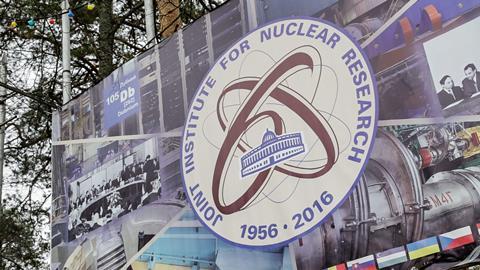
Oganessian’s lab is in Dubna, two hours’ drive north of Moscow. To get there means driving down a single-lane highway that cuts straight through a sea of pine forest, past a T-34 tank that marks where the Germans were stopped in the second world war. It’s a small town, set astride the Volga river and filled with statues, murals and identical blocks of modernist buildings. It’s also a naukograd – one of Russia’s official science towns. So the statues include Dmitri Mendeleev and nuclear physicist Georgy Flerov, the painted murals are of atomic fusion and the identical buildings lead down toward the Joint Institute for Nuclear Research (Jinr).
Jinr itself is far from imposing. A clutch of old buildings set apart from the town by a train track, the only sign of its importance is the army personnel on the gate, checking papers with AK47 rifles within easy reach. Once inside, the campus is a neat street of buildings, the only sign pointing the way to the canteen hut. Built in 1956 to rival Cern, Jinr has seven different atomic labs. The Flerov lab – where Oganessian has worked for 50 years – is second on the right, a pile of dewars filled with liquid nitrogen by the door. The caps have long been lost; these days the scientists use tin cans as a lid. It’s the only thing that suggests the building houses five cyclotrons. A few hundred metres down the road, another cyclotron is under construction; the lab’s director, Sergey Dmitriev, keeps a webcam of the progress on a constant feed in his office, watching the surreal sight of a lone cleaner mopping around a 2000-ton magnet in an otherwise empty hall.
Oganessian works next door to Dmitriev. His office is large, wood-paneled and filled with books, papers and mementos. He has an unmistakable sparkle in his eye and extremely personable manner. Behind the desk is an A3 photo of his grandson (‘he just cycled around the whole of Manhattan in a race!’); in the far corner is a chalkboard with diagrams by Flerov, who died in 1990. Oganessian has had a glass pane erected in front of it so his mentor’s writing can be preserved.
Flerov is the reason Oganessian became the world’s leader in superheavy elements. Initially dreaming of becoming an architect, he graduated in 1956 from the Moscow Engineering Physics Institute, and was almost recruited by Gersh Budker at the Institute of Atomic Energy in Moscow, but there were no vacancies on his team. Instead, Flerov recruited Oganessian to lead the team constructing the U300 heavy ion accelerator in Dubna. ‘I came to the group of Flerov, and the group was defined by Flerov!’ Oganessian remembers. ‘We didn’t just look at properties [of superheavy elements]. We looked at nuclear reaction, interactions, types of decay, nuclear fission, alpha emission: the wide field of nuclear physics and chemistry. And it was interesting, so I continued that up until now – I’m still interested!’
Transfermium ‘wars’
The theory behind creating a superheavy element is simple: you smash two atoms together and hope they combine to make a bigger one.
The problem is that for two nuclei to fuse, the electrostatic repulsion between their positive charges has to be overcome and that means the collision has to take place at very high energies. Typically, this involves firing a light element projectile at a heavy element target. Highly charged ions of the lighter element are accelerated in a cyclotron – powerful magnets propelling the ions in a circular orbit to around 10% of the speed of light. These ions then exit the cyclotron as a beam (with intensities of trillions of ions per second) that is shot at the target. Then comes the hard part. Even if it there is a collision, usually the two nuclei just break apart. Most of the time, the repulsive force between the protons will beat the attractive force that binds the nucleus together and the whole thing is torn apart. But very occasionally, the nuclear strong force wins out: the two nuclei fuse together and relax to a ground state, and a new element is born. Trying to make heavier elements means packing more protons into the nucleus, increasing the chance it will break up. This can be compensated by using neutron-heavy isotopes; the nucleus can stabilise by shedding energetic neutrons.
Finally, you have to separate the single atom you’ve produced from the huge amounts of unreacted material and unwanted byproducts and get it to the detector. Then, by recording the chain of alpha decays emitted as the atom disappears into a cascade of lighter elements, you can prove what you’ve created.
In short, creating a new element is the equivalent of shooting a machine gun at a needle in a haystack, hoping the bullet and needle fuse together, then catching the bullet–needle as it ricochets out, knowing that in less than a second it will vanish forever.
To even get to this stage was a challenge for the 28-year-old Oganessian when he started at Dubna: none of the team he led had ever built a cyclotron. They weren’t even sure if it was the best approach. In the US, the team at the Lawrence Berkeley National Laboratory – led by Seaborg and Albert Ghiorso – were using linear accelerators, which were viewed as a more promising alternative. The US team had already created eight man-made elements up to number 100.
In Oganessian, Flerov had found the perfect team leader. ‘Yuri has the uncanny ability to get people to work together,’ says Yennello. ‘He’s down to Earth, enthusiastic. He explains things in great ways. Every time you have a conversation you go away thinking “I wouldn’t have thought of it like that”. It’s because he’s so personable. It’s because he’s Yuri.’
On 9 September 1960, the first beam of nitrogen ions was accelerated through U300, with Oganessian as chief engineer. It would be the most powerful accelerator in the world for the next decade. In 1968, in a quest for more beam time, Oganessian oversaw construction a second, smaller, cyclotron; this time without any outside help and incorporating his own improvements. Jinr was beginning to outpace the Americans. A year later, the 36-year-old completed his doctorate, devoted to nuclear fission by heavy ions.
When the politicians are having struggles talking, scientists are still performing our work. We try to keep the politics out of it.
Mark Stoyer, Lawrence Livermore National Lab
Now 83 years old, Oganessian marvels at how far science has come. ‘Every time someone finds an answer, it depends on how they accept and imagine the world,’ he says. Before U300 and the Berkeley experiments, anything beyond element 100 was thought to be a ‘forbidden area’, Oganessian explains. ‘I was quite surprised that such heavy elements exist, because until 1960 we were satisfied with the classical model, based on George Gamow’s idea, that the nucleus [of an atom] was like a drop of liquid. But Niels Bohr and John Wheeler used the theory to show that no element beyond 100 can exist, that this is the end.’
By 1974, Bohr and Wheeler had been proved wrong. Elements up to 106 had been synthesised by fusing combinations of targets and projectiles from uranium with boron up to californium with oxygen. But the ground-breaking achievements had attracted cold war politics, as both the US and Soviet teams claimed to have made the discovery first. To the Americans, elements 104 and 105 were rutherfordium and hahnium; to the Russians, they were kurchatovium and nielsbohrium.
Today, 104 is rutherfordium and 105 is dubnium. Indeed, so many names were used during the ‘wars’ that they were only universally agreed in 1997. Yet Oganessian makes it clear that any animosity was solely on the part of the diplomats. In his library, he has a collection of black and white photos, including one of him leading Flerov, Seaborg and Ghiorso around Dubna. Other photos are of him explaining techniques to Seaborg; of Seaborg writing notes for Oganessian to read. The black and white images show how the transfermium ‘wars’ were far from combative.
‘That’s where politics comes in, and it’s a little unfortunate,’ says Lawrence Livermore’s Stoyer. ‘When the politicians are having struggles talking, scientists are still performing our work. We try to keep the politics out of it.’
‘In the prior Soviet Union and the US during the cold war, we sustained a scientific connection,’ agrees James Roberto, associate laboratory director of Oak Ridge National Laboratory in the US. ‘Both countries realised that having connections was useful, and that science was a vehicle for having connections that were too challenging otherwise.’
Oganessian knew instinctively how vital these connections would be. And it was this spirit for working with others – and his rebellious deference to science above politics – that would lead Oganessian to make the next step in the superheavy element story: cold fusion.
Guerrilla fusion
‘My lovely reaction, cold fusion.’ Oganessian’s smile grows wider when it’s mentioned. In his office, among the papers and curios – a licence plate from the UFO research centre in Roswell sits next to numerous accolades – are tables of element decay chains, showing the isotope half-lives made possible by the technique. It was cold fusion that would move the element story onward.
Oganessian had been appointed chief engineer in 1961, but almost immediately began to chafe against the lab’s direction. Flerov discouraged innovation, telling his team ‘don’t dabble in zoology, let other people do it’ whenever they suggested an alternative approach. Those who strayed caught the director’s ire: he branded such discoveries ‘guerrilla warfare’ and treated breakthroughs with cool indifference. In Flerov’s mind, the worst thing a guerrilla could do was prove themselves right.
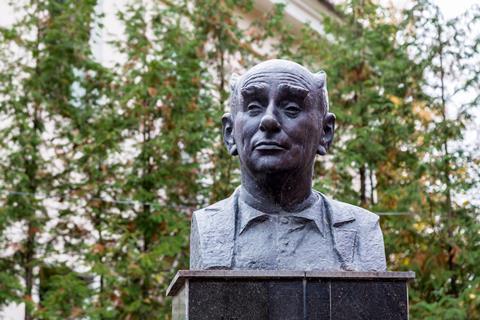
Oganessian was one such guerrilla. Throughout the 60s he had organised a group of young researchers to explore a diverse range of scientific concepts. Now, he had an idea that he couldn’t ignore. Results of fusion reactions were decreasing sharply as the atomic number grew higher. The cause was the high excitation energy (40–50MeV), which increased the chance of the element breaking up. To create new elements, the excitation energy needed to be minimal, or ‘cold’. Instead of firing a very light element at a heavy one, two elements should be chosen that were closer together.
When Flerov went on an expedition to Siberia, Oganessian seized his chance. Testing his theory, he fired argon-40 at lead-208 to make fermium-244, predicting it would shed four neutrons and create an isotope with a half-life of only 4ms. The new technique produced fermium-246, losing only two neutrons, with a half-life of 1.1s. The resulting yield was 10,000 times greater than he imagined. Cold fusion occurred at an energy close to the coulomb barrier, meaning the formed nucleus had an excitation energy 2–3 times lower than any technique used before.
Oganessian reported his discovery to Flerov on his return. At first his mentor appeared dismissive – the usual fate for a successful guerrilla. It was only when the president of the USSR Academy of Sciences visited Jinr that Flerov pointed to Oganessian and said ‘He produces transuranes in their tens of thousands.’ The president, realising what this meant, gave Oganessian a kiss on his cheek.
Jinr’s records call the kiss his ‘reward for insubordination’. The actual reward was new elements. By 1996, in partnership with the team at the Helmholtz Centre for Heavy Ion Research (GSI) in Darmstadt, Germany, cold fusion had led to the discovery of elements 107 to 112. Two decades later, cold fusion would have its swansong with the discovery of element 113 (now called nihonium) by a group led by Kosuke Morita at Riken’s Nishina Centre for Accelerator-based Science in Wako, Japan. The Japanese search had started in 2003, bombarding bismuth with zinc ions.
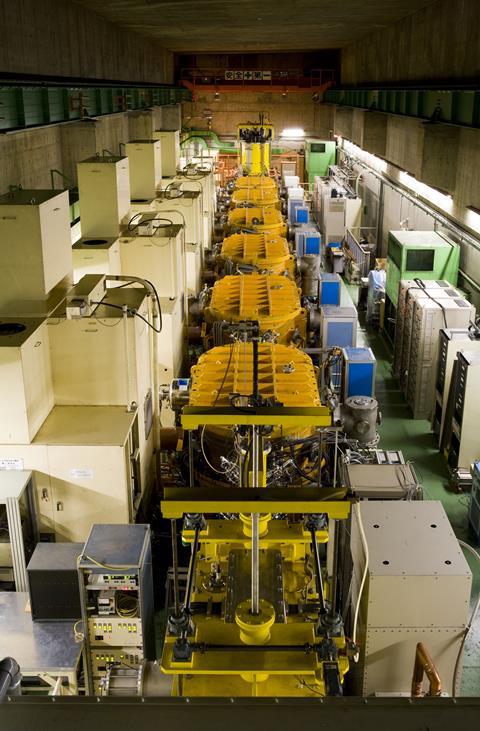
By April 2005, they had only seen element 113 twice – not enough to prove its existence. ‘For over seven years, we continued to search,’ says Morita. ‘We just never saw another event. I was not prepared to give up.’ He didn’t: the Japanese team finally saw a third event, enough to satisfy the requirement for a confirmed discovery, in August 2012. ‘The probability of an event was low, but finite,’ explains Hideto En’yo, director of the Nishina Centre. ‘The team knew it would come, because they had it twice in two years. The difficulty was they did not know when it would come.’
The limited yield proved the days of cold fusion were over. ‘It became redundant,’ Oganessian sighs. ‘Yes, it can make heavy elements. But not super-heavies, because they need more neutrons. There’s no chance, no neutrons. Lead is less neutron-rich than transuranium elements.’
By the time Riken had seen its first event, Oganessian and his collaborators had already moved on to a new technique. With hot fusion, a joint team of Russians and Americans were about to push the boundaries of the periodic table to their limits.
Part 2: Discovery chains
On the floor below Oganessian’s office sits the U400M accelerator, running 24 hours a day. It’s a behemoth: a massive, two-floor cyclotron that hums constantly with power, its beam lines hissing as pressure is released. Frost gathers at some points, revealing the liquid nitrogen within. The main beam line extends out into a large, sealed chamber that houses the highly radioactive target. At its heart is a 2100 ton magnet – built from 15m sheets of rolled metal on a purpose-built tooling machine – with 11 beam lines. It fires heavy ion beams, with energies of up to 270MeV per nucleon, at an intensity of 6 × 1012 ions per second. When a target is hit, it travels to the detector via a gas-filled recoil separator in under 1µs – meaning it can only detect isotopes with half-lives longer than that.
‘The main task of my group at the cyclotron is to study the chemistry of superheavy elements, extremely challenging fundamental problem,’ explains Nikolay Aksenov, head of the radiochemical group at the Flerov lab, his voice raised against the mechanical hum. ‘These experiments are very expensive. But you need more investment. Not only investment for experiments and equipment here, but investment for unique isotopes production that’s used for our targets and calcium-48.’
This expense is because cutting-edge superheavy discovery uses calcium-48, an unusually neutron-rich projectile. ‘Natural calcium is a bad isotope,’ explains Oganessian. ‘It has 20 protons, 20 neutrons. But in natural calcium, about 0.19% [of it] is calcium-48, which has 20 protons and 28 neutrons. It’s very expensive, terribly expensive. One gram of calcium-48 costs $200,000 (£160,000).’ During operation, the accelerator uses 0.5mg an hour, with experiments running for weeks at a time.
Given the cost, an obvious question is why the research is being funded at all. Shouting over the noise in the room, the lab’s director Sergey Dmitriev makes the answer loud and clear. ‘It’s the fundamental question – where is the boundary of the periodic table? We don’t know how the heaviest elements are formed. Where is the boundary of the nucleus?’
Islands in the beam
The collaboration to address these fundamental questions began in 1989, when Ken Hulet from Lawrence Livermore met Flerov at a conference. Both nuclear physicists were facing problems, explains Stoyer. ‘At that time, the folks at Livermore were having difficulties getting beam time, and the folks in Russia needed some technical help with detectors, computers, electronics, things like that. And so they decided to form a collaboration.’
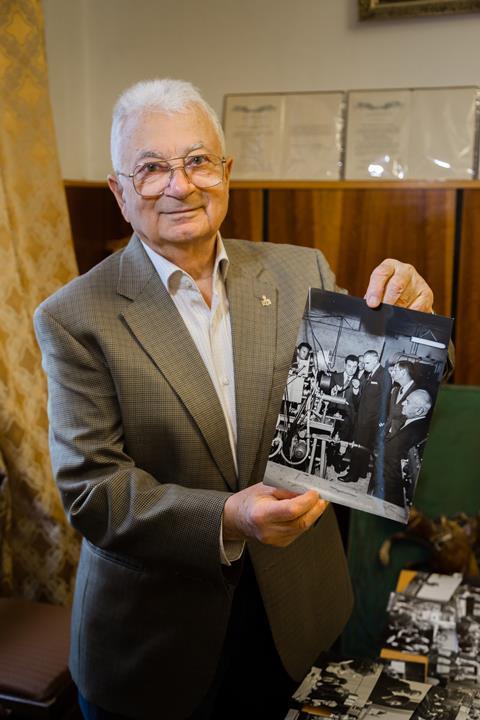
Flerov had by then stepped down as the nuclear reactions lab director, with Oganessian appointed as his successor. Oganessian had also become a member of the USSR Academy of Sciences. The night before his election, Flerov had sent academy members a letter: ‘Heavy ion physics is developing intensively in the US, Germany, Great Britain and France. We should not only hold our ground but strengthen our positions. Thinking about the person I would entrust with the entire complex of works in heavy ion physics, I pronounce without hesitation the name of my disciple Yuri Tsolakovich Oganessian. A remarkable physicist and experimentalist… his work is characterised by originality, an ability to approach a problem from an unexpected side, and to achieve an ultimate result.’
Flerov died a year later, but Oganessian ensured the collaboration with the Livermore team continued. Initially, they experimented on the still-unnamed element 108. But the team’s true aim was element 114 and the island of stability.
We had to improve our technique. We had to improve our detectors. We had to improve our separators. We had to improve the beam intensity.
Mark Stoyer
The island of stability. En’yo calls it the ‘dream of nuclear physicists’. Others say it’s the biggest prize out there, one that could revolutionise energy or change the face of warfare. The theory, first proposed in the 1960s, is that a region exists where certain proton and neutron compositions create nuclei that are more stable than other isotopes, reversing the trend of increasing nucleus instability. Rather than resembling a drop of liquid, as Gamow suggested, the protons and neutrons in a nucleus fill ‘shells’, similar to electrons in atoms. Isotopes with filled shells should prove far more stable. The aim was to hit an isotope with a ‘magic number’ of protons or neutrons. ‘With these magic numbers we have more binding forces,’ Oganessian explains. ’The first, not very stable but more stable than its neighbours, is 108 – hassium – with 162 neutrons. But come up further, up to element 114, with 184 neutrons, and it is a much more stable zone.’
A more stable zone would mean isotopes with longer half-lives. Rather than vanishing in a fraction of a second, an atom could last a thousand years, allowing scientists to experiment on it, even harness its energy in nuclear reactions of unprecedented force. ‘The island of stability was the [guiding] light for our experiment,’ says Oganessian. ‘But all attempts by the end of the 90s were unsuccessful. [To get there] you have to synthesise a nucleus with a high neutron density.’
In 1998, the team decided to attempt to synthesise element 114 again. Stoyer was recruited, joining his wife Nancy, John Wild, Ken Moody and Ron Lougheed from Livermore; Hulet had since retired. ‘The first experiment we did was calcium-48 plus plutonium-244,’ Stoyer recalls. ‘That experiment had been running in the past and nothing had been seen. So we had to improve our technique. We had to improve our detectors. We had to improve our separators. We had to improve the beam intensity. We had a lot of improvement that we had to go through.’
Stoyer describes his initial visit to Jinr fondly. ‘It hasn’t changed much since 1998; it’s still the same. We would sit there and we would get summoned up to come and visit Yuri in his office. He’s a fairly methodical, kind of a calm, quiet person. You have to listen a little bit and then you’ll hear the nuggets: he generally has in his mind what he wants to talk to you about.’
Sadly, Stoyer missed the team’s breakthrough. ‘I went in November 1998,’ he says. ‘My wife went one month later, in December 1998. We like to joke, because in between was when the first event was observed.’
The team had successfully made element 114; the isotope they had made was not on the centre of the island, but close enough to prove it existed. ‘If there was no stability,’ Oganessian says, ’it would have a half-life of 10–19 seconds. There’s no meaning to talk about an element in such a short time, you can’t detect it. But the effect we saw was a decay of seconds – 19 orders of magnitude higher. That was strange. And the decay emitted an alpha particle and transformed into 112, with a half-life of minutes.’
‘The Russians were very keen to announce,’ Stoyer recalls. ‘It was one decay chain. We were still finishing our analysis [but] in the end, we did agree. There were some minor points of difference which we were able to sort out, but I remember it was a very busy Christmas and New Year because we were working like mad trying to analyse the data, and they were like “we want to announce!”’
Now confident their technique, hot fusion, was a success, the team moved on to element 116. ‘Our plan was to investigate, try to look for this region of enhanced stability,’ says Stoyer. ‘We did the 114 experiment first, and then we moved to 116, because even-atomic-number elements are easier to make and observe than odd elements. We changed to a curium target.’
Once again, the team was successful. But this time they weren’t alone. A rival team from Berkeley, led by Victor Ninov, had also claimed they had discovered element 116. And what’s more, the Berkeley group reported seeing evidence of element 118.
The Ninov fraud
Ninov had come to Berkeley from GSI in Germany, where he had already been involved in the discovery of elements 110–112. The Berkeley team used cold fusion experiments, firing krypton at lead. Hugely respected in the field, Ninov processed the results using GSI’s software; as the only one familiar with it at Berkeley, he was put in sole charge of analysis.
Writing down his results on two pieces of yellow paper, Ninov claimed three instances of element 118, forming element 116 as part of its decay chain. The team published their results in Physical Review Letters. It seemed to be the greatest coup in superheavy element discovery. In truth, it was one of the greatest frauds in science.
It’s good that Seaborg died before this, it would have just about killed him.
Albert Ghiorso, Lawrence Berkeley National Laboratory
The Berkeley findings were soon disputed. Scientists at GSI and Riken were unable to verify the results. When Berkeley ran the experiment again, there was no trace of the elusive 118. An internal investigation checked the equipment, but at this point no one considered fraud. Then, in 2001 Ninov claimed to have found 118 again. This time his data was analysed: there was no sign of what he said he’d found. Looking back at the original discovery, there was no sign of 118 in the raw data, either.
Over the course of multiple investigations, it became clear that the records had been altered to create the event claimed to show element 118. At least one of the original chains had been altered, too, using Ninov’s account. Despite his denials, Ninov was fired. By then, the rest of the team had already retracted the claim.
Ghiorso’s assessment of the episode to the New York Times was blunt: ‘It’s good that Seaborg died before this, because he would have been one of the co-authors. This would have just about killed him.’
Ninov’s deception exposed, the hunt for elements was back on. ‘The Victor Ninov, the 118 thing, came out right when we were going through 114 and 116, and trying to get credit,’ Stoyer recalls. ‘It was a black eye for the field. But what it did is that it highlighted our method, how our collaboration handled that kind of thing. The data is taken in Dubna, but it is analysed in Dubna and Livermore. It’s analysed by different codes, by different people, checking and cross-checking each other. So we had a level of quality control built in to our analyses. We were able to say to Iupac: “Hey! We have multiple people looking at this with different codes and coming up with the same answers!” It gives you more confidence in the final results.’
Oganessian’s description of what happened next makes it sound simple: ‘We made 114. We made 116 and 118. They showed high stability. Then we came to the odd isotopes. They also showed high stability. So, step by step, we came from 110 to 118.’ The reality is more complex. Calcium-48 had proved the perfect beam, but element 118 was a challenge because of the target. ‘We used californium-249,’ Stoyer says. ‘That and berkelium are probably the nastiest targets to work with from a radiation-handling perspective.’
During the 2000s, the team also made element 115 with americium, and had seen it decay to element 113. Oganessian pressed the team to publish. ‘I was on sabbatical,’ Stoyer recalls, ‘and I remember thinking to myself “Why are we rushing, why are we doing this so fast? There isn’t anybody else doing this experiment.” About six months later, the Japanese results came out.’
At the time, neither the Russian–US or Japanese attempts were enough to satisfy Iupac that element 113 or 115 had been discovered. The teams both needed more data. So, while Riken continued its search with cold fusion, the Russian–US team set their sights on element 117 – an element that they predicted would decay to form both 115 and 113.
There was only one problem: to produce 117 with calcium-48, the team needed berkelium. And the only place in the world that made berkelium was the high flux isotope reactor in Oak Ridge National Laboratory in Tennessee, US.
Joe Hamilton’s Tennessee hold ’em
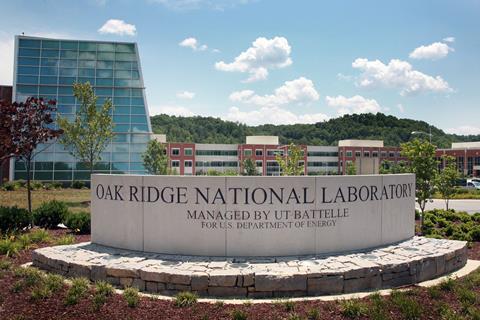
Joseph Hamilton is a professor at Vanderbilt University in Nashville and a long-term Oganessian collaborator. By 2005, they had already worked together for 20 years, publishing more than 200 papers together. When the Jinr–Livermore team needed berkelium, Oganessian made a visit to his friend, also a distinguished fellow at nearby Oak Ridge. It was a visit that led him to dub Hamilton ‘the father of 117’.
‘He came to see me in 2005, and we went and talked with the people at the high flux reactor,’ Hamilton says. ‘They said the only economical way to get berkelium is to piggyback a commercial company order for calfornium-252, because berkelium-249 is a byproduct. They said “We have no order for californium, and no immediate expectation for an order”.’
It was a setback, but Hamilton wasn’t about to give up. ‘For the next three years, I called every three months. I called the high flux isotope reactor scientists and asked them if they had an order for californium. Hamilton’s tenacity is the stuff of legend in the group, says Stoyer: ’He pounded on the door every month: “Can we get berkelium? Can we get berkelium?”’
In 2008, Oak Ridge finally confirmed they were going to produce californium. By chance, the next month Hamilton was celebrating his 50th year working at Vanderbilt and a symposium had been arranged in his honour. Both Oganessian and Oak Ridge’s then deputy director James Roberto would be in Nashville for the celebration. ‘I got the two of them together at the luncheon,’ he recalls, ‘and Yuri convinced Jim that we needed to collaborate.’
This was Roberto’s first encounter with Oganessian. ‘I was very impressed,’ he says. ‘I was convinced that, based on what had already been accomplished, the synthesis of 117 was possible. I was also impressed by the scientific value of the experiment. I was convinced that this was a scientific problem worth addressing.’
By now, the team aiming for 117 had expanded to include Lawrence Livermore and the University of Tennessee. But berkelium would prove a difficult target, with production needing to start two years in advance of the experiment. ‘We had to agree a schedule under which we could produce berkelium and line up with the availability of the accelerator and beam in Dubna,’ explains Roberto. ‘It took a little more than a year in our reactor [to get berkelium], then several months of chemical processing in our hot cells in order to purify it. At that point, the clock starts ticking.’
The urgency is because berkelium’s half-life is only 310 days. The small yield – the Oak Ridge team had produced only 22mg – meant that the target had to be rushed to Jinr for the experiment to take place. If anything went wrong, the team would lose their chance.

Roberto describes the time as ‘hectic’. ‘But it actually worked out marvellously. When you think about everything that had to work, the purification, the reactor, the accelerator, the details of the shipping process – all of that had to work very well in order to maximise the possibility the experiment was going to succeed. We were just in one of those circumstances where everything aligned very well.’
Bombarding berkelium with calcium-48, the team once again succeeded in creating a new element. Better still, the alpha decay of 117 produced 115, as predicted. The discovery of 114 and 116 had been confirmed by Iupac. Now, the team had to wait for the panel’s deliberations on the rest of their discoveries.
In December 2015, the results were announced. Jinr and Livermore would be recognised as discovering 118; Oak Ridge would be added to the discovery of 117 and 115 (Vanderbilt and the University of Tennessee were left off the announcement in an oversight, later corrected). Element 113, however, would be awarded to Riken.
Dmitriev is magnanimous. ‘Of six new elements, Iupac recognises five for our institute. We’re quite happy – our Japanese colleagues spent 10 years for the synthesis of three nuclei. Professor Morita is our good friend, he spent many years in our laboratory. He’s our pupil, so it’s not a problem for us!’
A few months later, the teams met to decide the possible names. But Oganessian was already looking at the next step. He had helped complete the seventh row of the periodic table and pinpointed the island of stability. Now, Oganessian’s mind turned to three questions. Could the team produce element 119 or 120? Could they hit the centre of the island of stability? And could they find superheavy elements in nature?
Part 3: Yield to the future
‘Element 118 is the last we can synthesise with calcium-48,’ Dmitriev says. ‘Nobody can produce fermium or einsteinium using the high flux reactor in the quantity required to make a target. So we need to increase the atomic number of the projectile. As a first step we would like to use titanium-50. It’s got two more protons but the same quantity of neutrons as calcium-48. The stability of the compound nucleus will be lower, and the cross section [probability of fusion] decreases at least one order of magnitude. When we produce 118, we produce about one nucleus a month. If it’s one order of magnitude less, it’s one nucleus per 10 months. We’re not so rich as to be able to spend that much time with a cyclotron!’
As ever, any experiment requires time with an accelerator – and demand for time with the equipment is high. Teams from around the world submit proposals, and beam time is booked months in advance. If the periodic table is to expand to its eighth row, Dmitriev explains, it will need the new, more efficient accelerator currently being built. At the moment, only the magnet is in place. It looks like a piece of metal in the middle of a building site, a massive circular platform covered in a transparent plastic sheet. Others parts are being cleaned – spray-hosed with litres and litres of acetone. Next year, fitted together on-site like a jigsaw, these will form the most advanced accelerator in the world.
The equipment almost never made it to Jinr. The magnet was manufactured in Ukraine, just as the 2014 crisis began. The part was shipped by train to Russia through the conflict zone, Jinr’s scientists hearing gunfire and explosions as they liaised with the manufacturers. Given its history, it’s not surprising Oganessian pats the magnet fondly, excited by the possibilities it offers.
‘This is 10 times more powerful than the existing [U400] core,’ Oganessian says. ‘The intensity will be 10 times more – if everything works well, we hope to have a beam in the next year.’ The new facility – the Superheavy Element Factory – will also have a separator at least twice as efficient as the current set-up. This efficiency could lead to the discovery of elements 119 and 120, the higher yield compensating for the decreased production expected with the titanium-50 beam.
Roberto is equally enthused. ‘The new accelerator should give us up to 100 times the discovery potential that we have now, when you put all the improvements in place,’ he says. ‘That means that we’ll be able to deal with smaller cross-sections, which I think is an excellent chance of getting to 119 and 120. I’m excited. It just doesn’t come fast enough.’
Jinr and its US collaborators won’t be alone in searching for new elements: Riken is already preparing to experiment with a new gas-filled separator and a move to actinide targets. ‘Cold fusion is not practical any longer,’ En’yo says. ‘We’re going to use curium targets and vanadium or chromium beams. We use a linear accelerator, not a cyclotron, for superheavy element discovery.’
The Riken team was delayed in 2015 when they did not have enough funding – the Fukushima incident had caused their electricity bill to rise beyond their budget. Now the team is back on track. ‘We obtained supplemental funding this year to upgrade by installing a powerful ion source, and replacing some cavities with superconducting ones,’ En’yo says. ‘This will increase the beam intensity by five: we’ll have a five times larger chance to discover a new element.’
Stoyer describes this competition between the groups as a ‘friendly race’. ‘The field is poised to keep moving forward. If you look at the history of the discovery of elements, it’s about three every decade, and that hasn’t slowed up. In my mind, I have no doubt we’ll find 119 and 120 in the next two to four years, maybe five. I’ll hedge my bet and say five years.’
En’yo thinks it could be longer. Although 119 and 120 are in reach, they are at the very limits of current technology. ‘It could be [discovered] in a year, but it will [probably] be much longer. Five to 10 years is the best guess at the moment.’
The exploration of superheavy elements has never been more active. Sherry Yennello, a nuclear physicist at Texas A&M’s Cyclotron Institute, explains it as a driving force in physics. ‘We want to know the unknown,’ she enthuses. ‘Is there an end? What does it teach us about the underlying nature? We’ve got to look. If we can do it, we ought to try. It’s about how we exist.’
Island hoppers
Expanding the periodic table is only part of the opportunity afforded by the new accelerator. Nobody knows where the table will end – Richard Feynman thought 137, others have suggested 172. It’s not known if there is another island of stability. Again, predictions vary: Oganessian himself proposed a second island around element 164 in 2008. ‘It’s a very good question, whether the island is the last one or not,’ he says. ‘The question is still about the interaction of two forces: nuclear forces, which are attractive, and coulomb forces, which are repulsive. When you get to higher states, can nuclear forces really compensate? They may. The question today is the size of the nucleus: if it expands a little bit, then we have a chance to go up to the next. People make brave theories at element 142, neutron number 228. It seems to me that such an estimate might exist. But the question is still open.’
The question is still about the interaction of nuclear and coulomb forces. When you get to higher states, can nuclear forces really compensate?
Yuri Oganessian, Jinr
Given this uncertainty, it’s unsurprising that attention has turned to the known island of stability, around element 114. Hamilton is keen to point out the practical applications. ‘When Seaborg and his group discovered californium-252, they made a few atoms of it. Then they discovered a way with high flux reactors to make milligrams and grams – and californium-252 became a very hot commercial topic because it’s a very compact source of energy and neutrons. It was used in the first space probes as an energy source. We’re only making a few atoms [of the latest superheavy elements now], but if we can get to the island of stability, we have much longer-lived isotopes, so you can stockpile that material.’
In this search, new players are arriving, with new approaches to the problem. Michigan State University in the US is currently building its Facility for Rare Isotope Beams, where Witold Nazarewicz is chief scientist. The facility uses a linear accelerator, and plans to accelerate beams to half the speed of light to create neutron-rich isotopes of elements that rarely occur in nature. The facility will cost $730 million and will be fully operational in 2022.
Nazarewicz is also searching for the island of stability. ‘The difficulty is we do not know how to get to this Holy Grail. There are many stable beams and targets – physicists are still discussing the best reaction. The truth is, we do not have theoretical models for fission with sufficient luminosity to make predictions.’
En’yo agrees. ‘The way to reach the island is not clear yet. The way to go is not simple: we can only reach it through accumulation of our knowledge of nuclear physics, experimental technology and accelerator improvements.’ Even if the island is reached, Dmitriev says, proving it will be a challenge. ‘OK, chemistry can isolate 114, no problem,’ he says. ‘But how do you say it’s 114? You need the alpha decay.’
This is the island’s inherent problem. The only way to prove an element has been created is to monitor its alpha decay into a smaller element. Currently, the most stable isotope of the heaviest elements that has been produced is flerovium-289, lasting around 2.6s. If flerovium-298, predicted to be the centre of the island, was synthesised, the half-life would be thousands of years: too long to show decay in an experimental setting. ‘If the half-life was 1000 years, you’d need at least one million nuclei to see one decay per day,’ Dmitriev explains. When will we reach a level to prove the island has been found? ‘10–20 years, I think!’
Yet there are other, even more exciting prospects with the chemistry of superheavy superheavy elements, says Oganessian. Work at the Flerov labs had produced a result so remarkable it demanded exploration: could element 118 be the end of periodicity?
The collapse of the periodic table
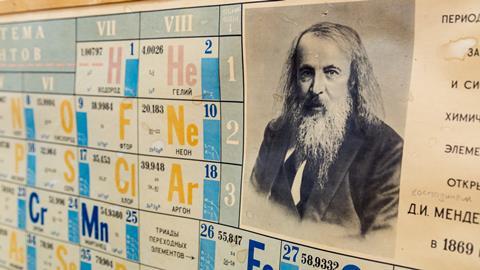
Away from the main accelerators there is a small room. This is the real Flerov lab: down a long, dusty corridor of cracked tiles and melodramatic twirling alarm bulbs; past traditional chemistry labs and up to the top floor of the building, out on to a small metal platform suspended within the gloom of interior shaft. Here, a visiting team from the Paul Scherrer Institut in Switzerland have set up their experiment.
The platform is cramped; the team brought half a ton of equipment, here and in their room downstairs. They’re here for the beam time – at a premium with so few facilities in the world capable of running their experiment. They have sought to make the most of their one-month slot, and use every minute to get as much data as possible. When the equipment malfunctioned at 5am on the last day, three hours before their beam time ended, group leader Robert Eichler dragged himself out of bed, through the sub-zero temperatures of the Dubna night, to make the repair. What, to a chemist, could be so important?
‘You might learn about the collapse of the periodic table,’ Eichler replies simply.
Jinr’s work means that superheavy elements can be produced in a large enough quantity, and with long enough half-lives, to study their chemistry, Oganessian explains. ‘Now, the question is about chemical properties. Do they follow periodicity? For example, is element 112 a homologue of mercury? Is element 114 a homologue of lead?’
If oganesson is not inert, if it is reactive, then it’s already happened: it’s the end of periodicity!
Yuri Oganessian
The classical theory – the one used to construct the periodic table – would say yes. But as you increase the charge of a nucleus, relativistic effects come in to play, Oganessian explains. Electrons gain velocity and come closer to the speed of light. ‘If it is close to the speed of light, the mass will increase – a relativistic effect – which is not taken into account.’
Of course, relativistic effects already occur throughout the periodic table: they explain why mercury is a liquid and why gold is golden. But, Oganessian argues, there may come a point where relativistic effects are so pronounced that elements no longer follow the trends of their period. ‘How about 118?’ Oganessian asks. ‘Is it a noble gas or not? Chemists would say “It would be a noble gas!” But if it is not inert, if it is reactive, then it’s already happened: it’s the end of periodicity!’
Proving this experimentally is what Eichler’s team, in collaboration with Aksenov and colleagues at Jinr, are working toward. They’ve been collaborating with Jinr since the 1990s, and Eichler’s father, an East German chemist, worked at the facility and he spent his childhood in Dubna. Aksenov jokes the reason Eichler is so successful is that his mindset is half German, half Russian.
The experiment is simple. It has to be, Eichler explains. ‘With single atoms, the chemistry is so diverse, you might fail and not observe anything. We cannot afford complex experiments with single atoms – it has to be yes or no, is it reacting with something, is it not reacting with something?’
The team is investigating copernicium and flerovium. The atoms are caught in a quartz chamber, then flushed through a Teflon capillary to the detector. ‘Here, there are two alpha radiation detectors looking at each other in an array – there are 32 of them.’ Historically, the detectors were coated with gold. Now, selenium – specifically red selenium – is used. The coating has to be powder-thin so that the detector still works. ‘If you look at group 12, all the elements occur in nature as sulfides or selenides, so they’re very stable compounds,’ Eichler explains. The gas streams pass through the channel. ‘There’s a temperature gradient applied, and if you have a temperature where the atoms react with the surface, they have a high chance of staying there.’
It’s this knowledge of the periodic table that forms the basis of the experiment. Knowing that other group 12 elements form a stable bond with selenium, the group expects that copernicium will follow suit. The only question is the temperature at which copernicium will deposit on the selenium. Work has already been done to extrapolate the group trend and work out the expected temperature. ‘Knowing it’s a line trend, we can calculate the enthalpy of sublimation,’ Aksenov explains. ‘Knowing this, we can calculate the enthalpy of formation of this compound, the thermodynamic values.’
The team point to neatly plotted theoretical predictions. Now, Eichler has the experimental data. It shows copernicium forming a bond with selenium at –20°C, and flerovium at –90°C – exactly as if relativistic effects were influencing group trends. If Oganessian is right, element 118 could be the end of meaningfully categorising elements in groups: the chemistry of the superheavy elements simply no longer fits the pattern chemists have been using for over 100 years. For now, Eichler’s experiments are proving the theory is sound. And, with the larger amounts of 116 and 118 created by the new accelerator, soon he’ll be able to do the chemistry to prove it.
The chemistry, Aksenov says, is also proving something else. Maybe we’ve been looking for superheavy elements in all the wrong places.
Messengers from space
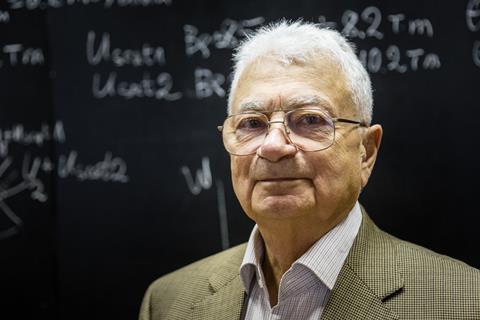
‘In the Soviet Union, there were big expeditions to find these [superheavy] elements in nature,’ Akesenov says. ‘They tried to find them according to the properties they thought they knew, because of extrapolations. They tried to find them in many earth materials, meteorites, cosmic rays.’
But the chemists at Jinr have shown that, at room temperature, superheavy elements are volatile, so the expeditions were a waste of time. If the superheavy elements exist on Earth, they’ll be at the poles, having fallen as cosmic rays and becoming trapped in ice at –120°C. Aksenov says the first question he’s usually asked is whether they’ll be in enough quantities to have a practical use: a copernicium nuclear plant to solve the energy crisis, or an atom bomb that could level a city. He laughs at the idea. ‘No. It’s not possible at all. Because of the half-life.’
Meteorites are like a flying lab: for detecting superheavies, they are ideal.
Yuri Oganessian
This, Oganessian agrees, is the real problem when it comes to finding superheavy elements. Even at the centre of the island of stability, the longest theoretical half-life is a thousand years. ‘The Earth, the solar system, has been around for 4.5 billion years,’ he says. ‘If you have an isotope of a billion years, it’s fine.’ Otherwise, the element is gone.
Rather than look to the poles for cosmic rays, Oganessian has a better idea: meteorites. His last meeting of the day is with a man who can help him realise this ambition. Richard Hoover was, until his retirement, the head of astrobiology at Nasa’s Marshall Space Flight Center in Huntsville, US. Now he’s a professor at the University of Buckingham, UK. The two men are looking at the cosmos.
‘Our interest is meteorites,’ Oganessian explains. ‘They’re like a flying lab: for detecting superheavies, they are ideal. They have been flying for many millions of years, and you can check them with a detector. In our case, the detector is olivine [a magnesium iron silicate mineral]. In olivine, if a heavy nucleus passes through it, it makes a track. This track ages and can be developed under a microscope. And the length of the track depends on the atomic number: you have a spectrum that can be calibrated. And if you find something heavier than uranium…’ Oganessian’s smile widens, that sparkle in his eye returning.
‘It’s a tremendously exciting possibility,’ Hoover agrees. ‘They are messengers from space, containing diamonds and olivine crystals that have been dated to be 4.6 billion years old. A large olivine crystal that’s in a pallasite [a meteorite containing iron and olivine] that’s been in space for 100 million years is like a photographic camera. But instead of taking an exposure for one minute, it’s taking an exposure of the elements that pass through it for 100 million years.’
The two men continue to confer. They have only just met but already chat as if they are lifelong friends. Oganessian’s unique skill for bringing people together means he has found his next collaborator. The hunt for superheavy elements in nature is on again.
For now, these next steps are yet to be realised. But it’s fitting that element 118, oganesson, could be the one that holds the answers to these fundamental questions. The superheavy scientists have come a long way since that conference call only months ago, when Oganessian’s friends and colleagues decided the element’s name. But what does the physicist make of the honour? How does it feel to be immortalised on the periodic table, next to the cold war giants – and his colleagues – Seaborg and Flerov?
‘It’s difficult to say,’ Oganessian says, blowing out his cheeks as he is momentarily overwhelmed by emotion. ‘Because it was proposed by my collaborators, it creates an honour for me, but it’s my friends and colleagues who want to express that opinion. I’m just looking and thinking there’s a lot of things to do, even with this element. This is not the final piece of the story.’
The author would like to thank Alexander Madumarov for his time and hospitality.








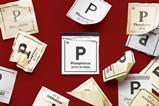
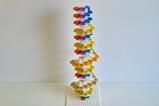


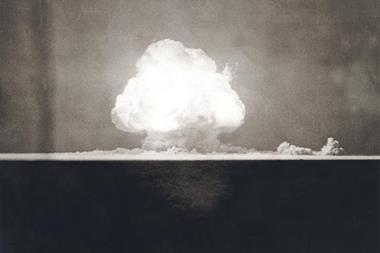
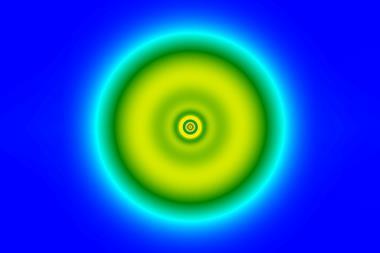
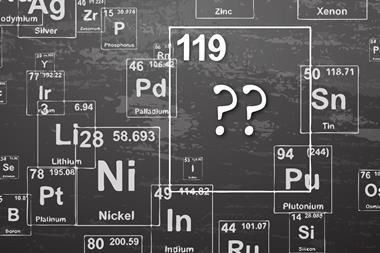
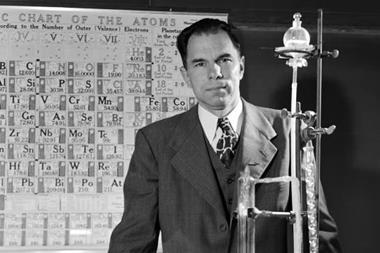








1 Reader's comment